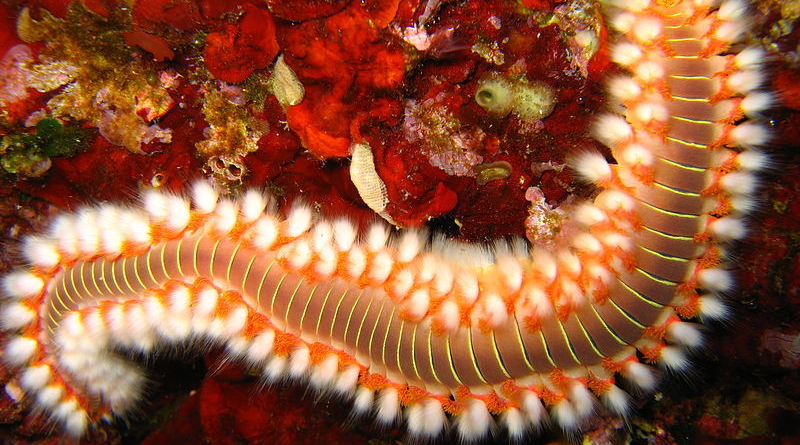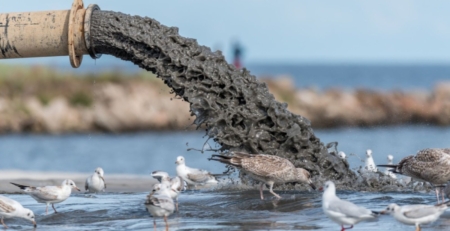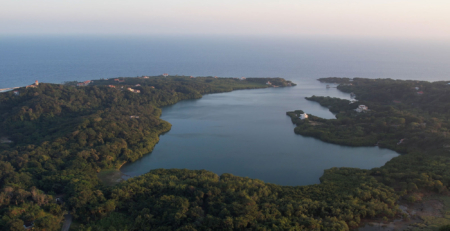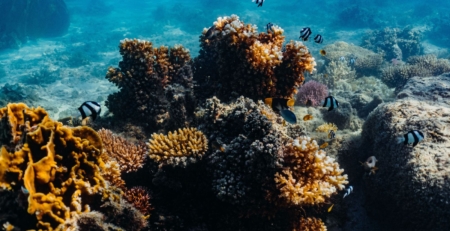Double whammy? Parasites in coral-eating fireworm poop
Written by Carly E. Karrick
Many types of microbes, microscopic-sized organisms, live in and on corals including algae, fungi, and bacteria [1]. When parasitic or disease-causing microbes make their way to corals, corals can get sick, stressed, and sometimes die [2]. So, how do these microbes find their way to corals in the vast ocean? More and more scientists are exploring how coral-eating animals spread microbes around a reef [3]. A team of scientists led by Anthony Bonacolta at the University of British Columbia (Vancouver, BC, Canada) recently found evidence that coral-eating fireworms (Figure 1) could spread parasites to coral.

Figure 1. Fireworms shown here consume coral tissue. Image from Bonacolta et al. 2025.
What are fireworms, and what do they have to do with corals?
Fireworms are predators that eat coral. They’re called fireworms because their venom causes a burning feeling if you’re stung. Researchers at the University of British Columbia, University of Miami, and Institute of Biological Evolution saw fireworms eating diseased coral tissue in Curaçao, so they collected samples of the fireworms and corals. They wanted to know if coral parasites are in fireworms based on their DNA sequences. If coral parasites are in fireworm feces, fireworms could pass parasites to corals as they poop on them.
Coral parasites are in fireworm poop!
The study found that coral parasites (corallicolids or Anthzooaphila spp.) were the most abundant microbes in fireworms. The parasites were specifically found in fireworm guts and poop. However, these parasites were different from the ones found on the corals that the fireworms ate. So, the researchers don’t know whether the parasites affect fireworms themselves or if the lifecycle of these coral parasites involves other non-coral hosts.

Figure 2. The relative abundance of different microbes in different parts of fireworms. The larger the dot, the higher the abundance of the microbe. Scientists found coral parasites (corallicolids), shown in purple in the figure above, in fireworm guts and poop (feces). Figure from Bonacolta et al. 2025.
We need more studies to better understand how fireworms spread microbes to corals.
While we now know that coral parasites are in fireworm poop, we don’t know whether fireworms spread these microbes to corals. We need future studies that explore whether microbes found in fireworm poop can be taken up by corals. If so, fireworms could spread parasites to other areas where they are invasive or expected to spread. However, fireworms could also spread good microbes to corals! In this study, researchers also found some beneficial microbes for corals in fireworm poop. Scientists like Kara Titus at Rice University (Houston, TX, USA) are currently studying fireworms in other areas to see whether these beneficial microbes are present. All in all, fireworms seem to have the potential to spread both “good” and “bad” microbes to corals, but we need to conduct more studies to fully understand this.
Read the full article here: Bonacolta, A.M., Weiler, B.A., Grimes, C.J., Trznadel, M., Vermeij, M.J.A., Keeling, P.J., del Campo, J. (2025). Fireworms are a reservoir and potential vector for coral-infecting apicomplexans. The ISME Journal, 19(1): wraf078. https://doi.org/10.1093/ismejo/wraf078
References
[1] Blackall, L.L., Wilson, B., and van Oppen, M.J.H. (2015). Coral – the world’s most diverse symbiotic ecosystem. Molecular Ecology, 24(21): 5330-5347. https://doi.org/10.1111/mec.13400
[2] Vega Thurber, R.L., Silva, D., Speare, L., Croquer, A., Veglia, A.J., Alvarez-Filip, L., Zaneveld, J.R., Muller, E.M., and Correa, A.M.S. (2024). Coral disease: direct and indirect agents, mechanisms of disease, and innovations for increasing resistance and resilience. Annual Review of Marine Science, 17: 227-255. https://doi.org/10.1146/annurev-marine-011123-102337
[3] Grupstra, C.G.B., Lemoine, N.P., Cook, C., and Correa, A.M.S. (2022). Thank you for biting: dispersal of beneficial microbiota through ‘antagonistic’ interactions. Trends in Microbiology, 30(10): 930-939. https://doi.org/10.1016/j.tim.2022.03.006











